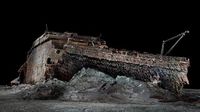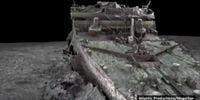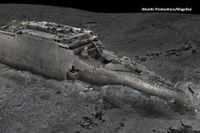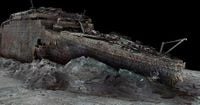On the 113th anniversary of the sinking of the R.M.S. Titanic, a groundbreaking documentary titled Titanic: The Digital Resurrection is set to unveil a stunning digital model of the infamous shipwreck. This unprecedented exploration utilizes cutting-edge underwater scanning technology to provide an accurate representation of the Titanic down to every rivet, revealing new insights into its tragic final moments.
In 2022, the deep-sea mapping company Magellan, in collaboration with Atlantic Productions, completed a comprehensive 3D scanning project of the Titanic wreck, which lies 12,500 feet (3,800 meters) beneath the surface of the North Atlantic Ocean. Using two remotely operated vehicles, named Romeo and Juliet, the team captured around 715,000 photographs and millions of laser measurements, resulting in one of the largest underwater 3D scans ever accomplished, amounting to 16 terabytes of data, equivalent to approximately six million e-books.
Parks Stephenson, a Titanic analyst, emphasized the significance of the ship, stating, "Titanic is the last surviving eyewitness to the disaster, and she still has stories to tell," as reported by the BBC. The digital twin of the Titanic allows researchers to explore its life-sized projection as if they were walking alongside the true wreck, providing a comprehensive view that was previously unattainable.
One of the most compelling findings from the digital scan is evidence that a heroic team of engineers continued to operate the ship’s electrical systems until the very end. The scan revealed concave boilers in one of the boiler rooms, indicating they were still functioning just before the ship became completely submerged. An open valve observed on the stern’s deck further supports this theory, suggesting that steam was still powering the ship’s lights as it sank. This aligns with survivor testimonies that reported the lights remained on until the very last moments, allowing the crew to launch lifeboats in relative safety rather than in total darkness.
Stephenson explained the importance of this discovery, noting that the engineers sacrificed their lives to keep the lights on, ultimately aiding in the survival of others. "They held the chaos at bay as long as possible, and all of that was symbolized by this open steam valve just sitting there on the stern," he said.
The digital twin also highlights other devastating features of the wreck, such as a smashed-in porthole that corroborates survivor accounts of ice entering some cabins during the collision. The collision itself lasted just over six seconds, with the Titanic designed to remain afloat even with four flooded compartments. However, the damage inflicted by the iceberg punctured six compartments, with some of the gashes no bigger than two sheets of A4 paper.
This new understanding of the Titanic’s demise contrasts sharply with popular depictions, such as in James Cameron’s 1997 film Titanic, which portrayed the ship splitting cleanly in two. The documentary reveals that the Titanic was violently torn apart, ripping through first-class cabins, where prominent passengers like J.J. Astor and Benjamin Guggenheim may have sought refuge as the ship went down.
One of the documentary’s notable findings is the confirmation that First Officer William Murdoch, long accused of abandoning his post, was likely swept away by the sea and unable to reach one of the few lifeboats on board. The Titanic only had about 20 lifeboats, which could accommodate just under 1,200 people, far short of the 2,240 passengers and crew aboard when the ship sank.
As the Titanic wreck continues to deteriorate at a fast rate, the digital scan serves as a crucial historical record. Anthony Geffen, CEO of Atlantic Productions, remarked, "What we now have for the historical record is, before it falls apart, literally a record of everything to do with the wreck of the Titanic, which will be around forever." With billions of dollars spent on expeditions to the wreck, it is imperative that researchers document the site accurately before it is lost forever.
The documentary, which premieres on National Geographic on April 11, 2025, and will be available for streaming on Disney+ the following day, aims to educate viewers about the Titanic’s tragic story and the heroic efforts of its crew. The new insights provided by the digital scan challenge long-held assumptions about the events following the Titanic's collision with the iceberg and offer a more nuanced understanding of the disaster.
As the world reflects on the Titanic's legacy, the documentary also raises important questions about the ethics of deep-sea exploration. Billionaire Larry Connor has announced plans to explore the Titanic wreck in 2026 using a submersible submarine, a move that has garnered criticism from governments and families of victims. Concerns about the potential for further damage to the site underscore the need for responsible exploration practices.
Ultimately, the digital twin of the Titanic not only preserves the memory of those who perished in the disaster but also opens new avenues for research and understanding. As Stephenson noted, "She’s only giving her stories to us a little bit at a time. Every time, she leaves us wanting for more." The Titanic continues to captivate the imagination, and with advancements in technology, there is hope that future generations will gain deeper insights into the ship's tragic story.







